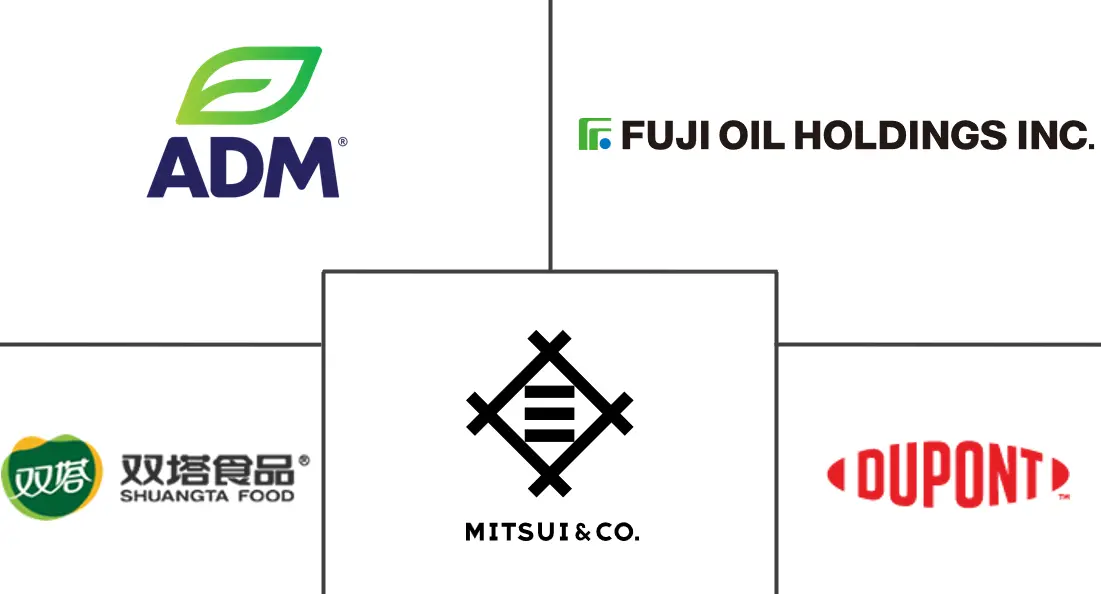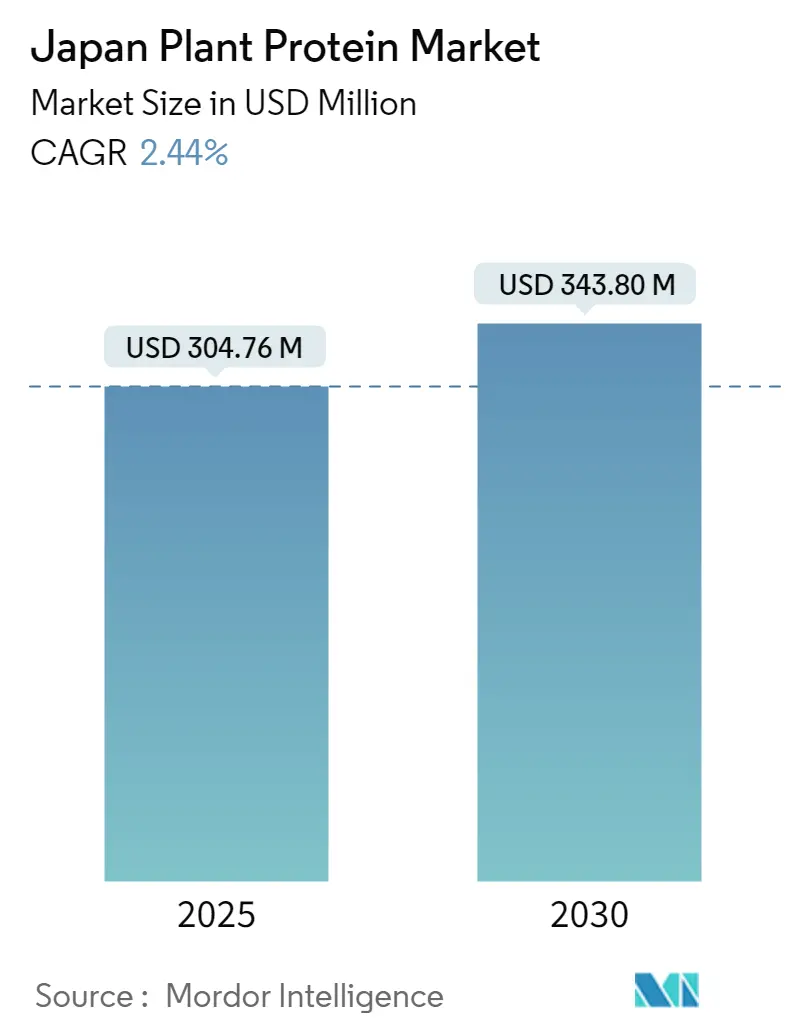
Japan Plant Protein Market Analysis by Mordor Intelligence
The Japan Plant Protein Market size is estimated at USD 304.76 million in 2025, and is expected to reach USD 343.80 million by 2030, at a CAGR of 2.44% during the forecast period (2025-2030).
The Japanese plant proteins market has seen significant growth, primarily fueled by shifting consumer preferences toward sustainable, plant-based diets. With growing concerns over health and the environment, many Japanese consumers are turning to plant proteins as alternatives to animal-based ones. Over the years, Japan has consistently produced various plant proteins, leading to market expansion. For example, in 2022, Japan's domestic wheat protein production reached 5.61 thousand tons, as reported by the Japan Plant Protein Food Association (JPPFA). Wheat gluten, a primary product, comes in granular, powdered, and paste forms. While it is used in mock meat, it is more commonly seen as steamed or baked dough blocks in Japanese cuisine. Japan's younger demographic, increasingly focused on sustainability and food trends, presents a key market. Companies must cater to them with affordable, appealing offerings to cement alternative proteins in their diets. Conversely, Japan's aging population, also called the silver generation, shows promise for plant-based proteins, given the challenges many face with digesting animal proteins.
Moreover, government initiatives, such as the Small and Medium-sized Enterprises Innovation Promotion Fund Project, are further propelling the Japanese plant proteins market. Notably, in January 2024, Japan’s Ministry of Agriculture, Forestry and Fisheries allocated approximately USD 27.7 million to two alternative protein startups: Umami United, specializing in plant-based eggs, and IntegriCulture, a cultivated meat biotech firm. These investments aim to bolster the nation's economy, enhance food security, and, consequently, drive market growth. Economic bodies like the Japan External Trade Organization are actively fostering collaborations with alt protein companies, both domestic and international, to bolster the market. Owing to these initiatives and market dynamics, Japan's plant proteins market is poised for continued growth in the coming years.
Japan Plant Protein Market Trends and Insights
Soy Protein Holds the Largest Market Share Among Protein Types
For centuries, soybeans have been a dietary mainstay in Japan, ingraining a cultural acceptance and familiarity with soy-based products. This deep-rooted connection lays a strong foundation for the widespread adoption of soy protein-based foods and beverages. Beyond cultural ties, soy protein's nutritional profile is a standout feature. It is a complete protein, housing all nine essential amino acids vital for human health. It is also low in saturated fats, devoid of cholesterol, and rich in essential vitamins, minerals, and dietary fiber. These attributes make soy protein a prime choice for health-conscious consumers seeking balanced, plant-based nutrition. The surge in soy protein's popularity in Japan is further fueled by a rising cohort with specific dietary needs. Vegans, vegetarians, and those grappling with lactose intolerance are driving the demand for soy-based offerings, viewing them as a reliable protein and nutrient source. This expanding consumer base is a driving force behind the escalating demand for soy protein products. For instance, data from the JPPFA reveals that in 2023, the domestic production volume of powdered isolates of soy proteins in Japan amounted to around 6.12 thousand tons, underscoring the demand for soy proteins as a meat extender in processed meats and its ability to be extruded as dough in meat substitute manufacturing.
Furthermore, the Japanese government's initiatives to promote healthy and sustainable diets have significantly bolstered the demand for plant-based proteins, notably soy protein. By backing R&D in the plant protein domain and advocating for plant-based fare in public institutions, these efforts have nudged not only consumers but also businesses toward embracing soy protein as a green and viable option. With a rising appetite for plant-centric diets and mounting concerns over the environmental footprint of conventional meat production, Japanese consumers are on the lookout for meat analogs that mirror the taste and texture of their animal-based counterparts. Here, soy protein is believed to excel in replicating meat's texture, making it a key component in plant-based meat substitutes, driving their market appeal.
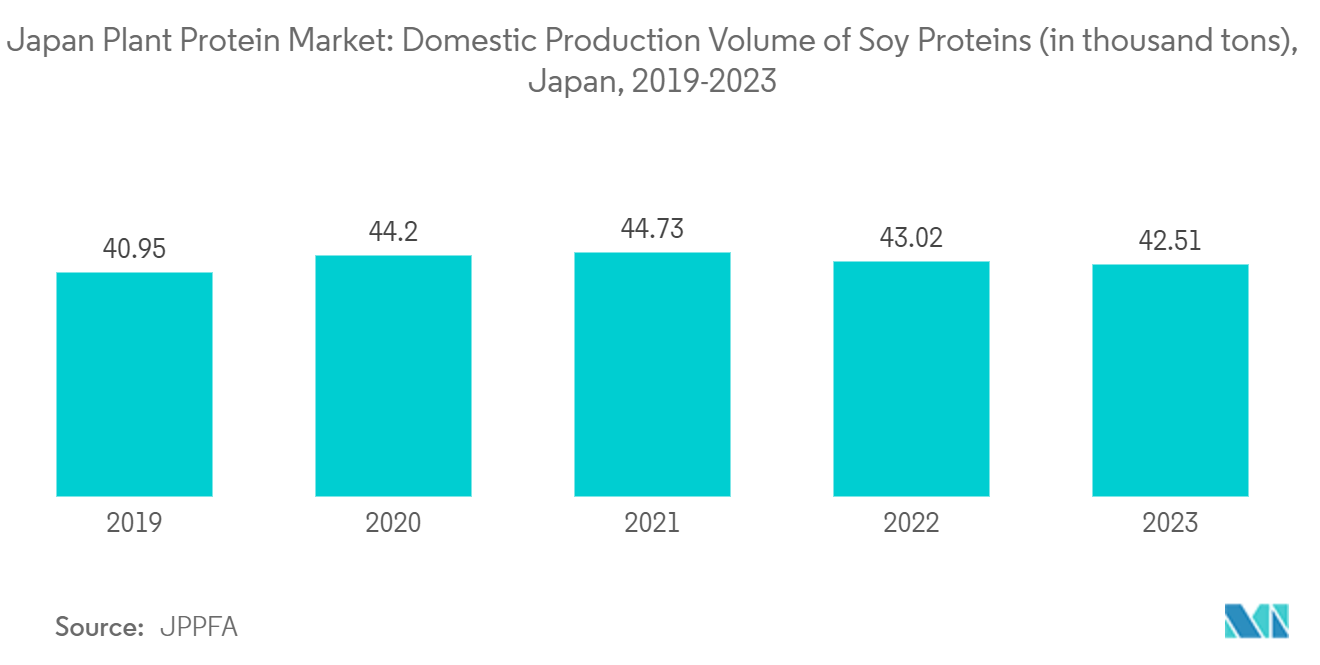
Increased Utilization of Plant Protein in Food and Beverages Driving the Market
Shifting consumer preferences from processed to healthier food options and growing demand for functional foods are key drivers of the Japanese plant proteins market. This shift has spurred the development of a range of plant protein ingredients, notably pea, rice, and soy proteins, for diverse applications, primarily in the food and beverages segment. The move toward plant-based diets is fueled by ecological concerns, health awareness, ethical considerations, and a focus on animal rights.
Japan's aging population is increasingly turning to plant protein foods. With age, individuals often require more protein to combat muscle loss issues like Sarcopenia. Plant proteins, being easily digestible and versatile, are being incorporated into foods and beverages tailored for seniors, further fueling market growth. Data from the World Bank in 2023 revealed that Japan's population aged 65 and over had increased by 2.62% from 2019, highlighting the demand for plant proteins among the elderly. Noteworthy, major players like Cargill and Roquette are channeling investments into plant proteins, viewing them as hypoallergenic alternatives to traditional sources like soy and wheat.
Furthermore, the surge in obesity, cardiovascular diseases, and diabetes in Japan is driving consumers toward vegan diets, which in turn is driving the demand for plant proteins. Projections by the International Diabetes Federation suggest a rise in diabetes cases, from 11 million in 2021 to an estimated 10.54 million by 2030, further underlining the growing demand for plant proteins. Plant proteins are known for their versatile applications, from extending or replacing ground meat in canned products like casseroles and meatballs to enhancing the nutritional profile of meat-based dishes. The broad applications and functional benefits of plant proteins are driving their adoption, with manufacturers increasingly incorporating them into their offerings. Given these dynamics, the food and beverages segment of the Japanese plant proteins market is poised for robust growth in the years ahead.
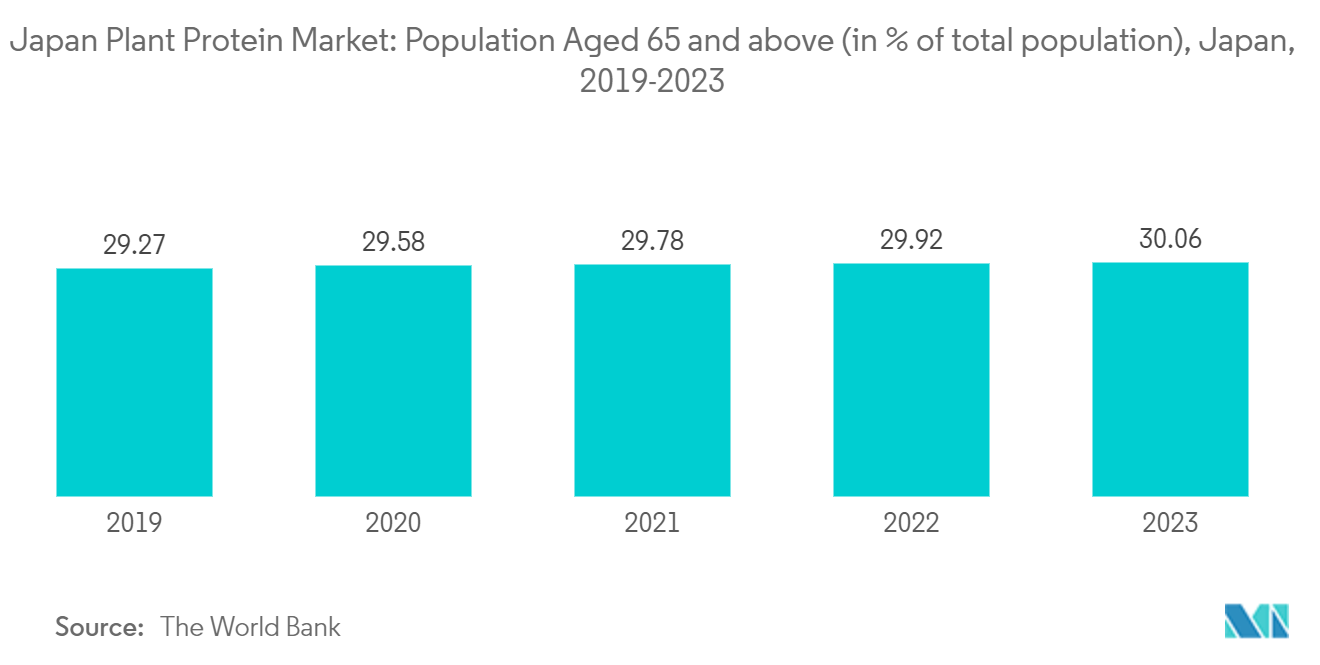
Competitive Landscape
The Japanese plant proteins market is fragmented, with the presence of the top five companies. The major players in this market are Archer Daniels Midland Company, DuPont de Nemours Inc., Fuji Oil Holdings Inc., Mitsui & Co. Ltd (Nippon Corporation), and Yantai Shuangta Food Co. Ltd. Key Japanese plant protein market players are investing in R&D and engaging in mergers and acquisitions to enhance their product portfolios. Owing to the rapidly developing nature of the market, new product innovation has become the most commonly used strategy among all players as it helps understand the changing needs of consumers in the market.
Japan Plant Protein Industry Leaders
Archer Daniels Midland Company
DuPont de Nemours Inc.
Yantai Shuangta Food Co. Ltd
Mitsui & Co., Ltd (Nippn Corporation)
Fuji Oil Holdings Inc.
- *Disclaimer: Major Players sorted in no particular order
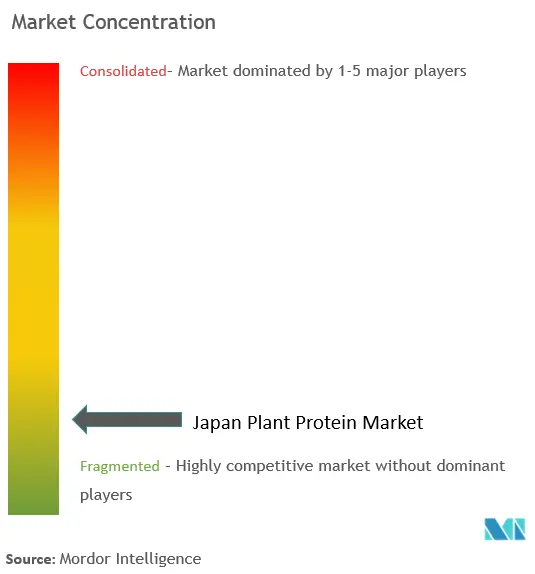
Recent Industry Developments
- October 2023: DAIZ, a plant-based meat company in Japan, as a part of its expansion strategy, raised about USD 47.44 million in a Series C funding round and utilized the funds to build a 40,000 sq. m production site in Kumamoto. As per the company's claim, the new manufacturing facility can produce 20,000 tons of plant-based “Miracle Meat” per year. Miracle Meat can be used to produce a wide range of meat alternatives, including burgers, gyozas, fried chicken, and tuna.
- June 2023: Agrocorp International, a Singapore-based global agrifood supplier, as a part of expanding its plant protein extraction business across Asia, entered a partnership with Japan's dairy giant Megmilk Snow Brand. This partnership enabled the company to manufacture soy-free plant protein products like pea protein, pea starch, and pea fiber, which can be used across a variety of plant-based foods and beverages, including plant-based meats.
- January 2023: Roquette, a renowned global leader in plant-based ingredients and a pioneering force in plant proteins, invested in Japanese food tech startup DAIZ Inc. This partnership enabled both companies to continue realizing their strong growth ambitions and meet rising global demand for innovative and sustainable plant-based ingredients combining great taste and high-quality nutritional value.
- December 2022: DSM introduced Vertis CanolaPRO, an exceptional high-quality canola protein isolate. According to the company's assertion, this protein isolate boasts a complete profile of all nine essential amino acids essential for maintaining optimal health.
- June 2022: Roquette, a global leader in plant-based ingredients, expanded its NUTRALYS plant protein range to better cater to the burgeoning consumer demand for healthier food choices. As per the company's claims, NUTRALYS rice protein stands out as a non-GMO, gluten-free, and delectable plant protein source. It can be seamlessly combined with NUTRALYS pea protein to provide a comprehensive solution for vegetarian protein supplementation.
Japan Plant Protein Market Report Scope
Plant protein is simply a meaningful food source of protein derived from plants. This group can include pulses, tofu, soya, tempeh, seitan, nuts, seeds, certain grains, and even peas.
The Japanese plant proteins market is segmented by protein type and end user. Based on protein type, the market is segmented into hemp protein, pea protein, potato protein, rice protein, soy protein, wheat protein, and other plant proteins. By end user, the market is segmented into animal feed, personal care and cosmetics, food and beverages, and supplements. Based on food and beverages, the market is further sub-segmented into bakery, beverages, breakfast cereals, condiments/sauces, dairy and dairy alternative products, meat/poultry/seafood and meat alternative products, RTE/RTC food products, and snacks. Based on supplements, the market is further sub-segmented into baby food and infant formula, elderly nutrition and medical nutrition, and sports/performance nutrition.
For each segment, the market size and forecast are offered based on value (USD).
| Hemp Protein |
| Pea Protein |
| Potato Protein |
| Rice Protein |
| Soy Protein |
| Wheat Protein |
| Other Plant Proteins |
| Animal Feed | |
| Personal Care and Cosmetics | |
| Food and Beverages | Bakery |
| Beverages | |
| Breakfast Cereals | |
| Condiments/Sauces | |
| Confectionery | |
| Dairy and Dairy Alternative Products | |
| Meat/Poultry/Seafood and Meat Alternative Products | |
| RTE/RTC Food Products | |
| Snacks | |
| Supplements | Baby Food and Infant Formula |
| Elderly Nutrition and Medical Nutrition | |
| Sports/Performance Nutrition |
| By Protein Type | Hemp Protein | |
| Pea Protein | ||
| Potato Protein | ||
| Rice Protein | ||
| Soy Protein | ||
| Wheat Protein | ||
| Other Plant Proteins | ||
| By End User | Animal Feed | |
| Personal Care and Cosmetics | ||
| Food and Beverages | Bakery | |
| Beverages | ||
| Breakfast Cereals | ||
| Condiments/Sauces | ||
| Confectionery | ||
| Dairy and Dairy Alternative Products | ||
| Meat/Poultry/Seafood and Meat Alternative Products | ||
| RTE/RTC Food Products | ||
| Snacks | ||
| Supplements | Baby Food and Infant Formula | |
| Elderly Nutrition and Medical Nutrition | ||
| Sports/Performance Nutrition | ||
Key Questions Answered in the Report
How big is the Japan Plant Protein Market?
The Japan Plant Protein Market size is expected to reach USD 304.76 million in 2025 and grow at a CAGR of 2.44% to reach USD 343.80 million by 2030.
What is the current Japan Plant Protein Market size?
In 2025, the Japan Plant Protein Market size is expected to reach USD 304.76 million.
Who are the key players in Japan Plant Protein Market?
Archer Daniels Midland Company, DuPont de Nemours Inc., Yantai Shuangta Food Co. Ltd, Mitsui & Co., Ltd (Nippn Corporation) and Fuji Oil Holdings Inc. are the major companies operating in the Japan Plant Protein Market.
What years does this Japan Plant Protein Market cover, and what was the market size in 2024?
In 2024, the Japan Plant Protein Market size was estimated at USD 297.32 million. The report covers the Japan Plant Protein Market historical market size for years: 2019, 2020, 2021, 2022, 2023 and 2024. The report also forecasts the Japan Plant Protein Market size for years: 2025, 2026, 2027, 2028, 2029 and 2030.
Page last updated on:
Japan Plant Protein Market Report
Statistics for the 2025 Japan Plant Protein market share, size and revenue growth rate, created by Mordor Intelligence™ Industry Reports. Japan Plant Protein analysis includes a market forecast outlook for 2025 to 2030 and historical overview. Get a sample of this industry analysis as a free report PDF download.
